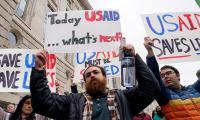LAHORE: The impact of Chinese investment on Pakistan economy will be positive, and could be substantial with a comprehensive and sustained policy effort.
Chinese investment in CPEC projects can accelerate economic growth in four ways. First, increased capital inflows will ease macroeconomic management and the balance of payments. Second, the infusion of investment and technology into infrastructure development will catalyse key productive sectors. Third, vibrant economic activity would attract investment from other countries, provided domestic investors lead the way. Fourth, the ensuing cross-border economic flows and enterprise supply chains will deepen integration in the global economy.
This was crux of the paper presented by Khalil Hamdani Former Director, UNCTAD on “Maximizing the Impact of Chinese Investment in Pakistan” in the fourth session of the first day of conference focused on “Leveraging CPEC for Balanced Growth II”. This session was chaired by Dr Navid Hamid Director, Centre for Research in Economics and Business (CREB), Lahore School of Economics.
Two days 14th International Conference on Management of Pakistan Economy, titling ‘Accelerating economic Growth in Pakistan: key macro and sectoral drivers’, organised by Lahore School of Economics (LSE) was started here on Wednesday. The regular sessions during the conference feature 25-five papers along with commentary from distinguished economists detailing the cutting edge research centered around macroeconomic stability, poverty, CPEC, industrial strategy, role of trade, change in the financial services industry and agriculture growth in Pakistan.
The second paper of the session entitled “Special Economic Zones (SEZs): A Comparative Analysis for CPEC SEZs in Pakistan” was presented by Professor at Jiangsu University Cui Yong with co-authored with Muhammad Muzammil Zia, Hasnain Javed and Beenash Afzal Malik investigated the assessment of socio-economic impacts of various Special economic zones SEZs in diverse regions via comparative analysis.
The analysis indicates that overall, African SEZs have not led to significant job creation or poverty reduction because of failures in implementing proper regulations. However, Asian SEZs on the other hand, have shown many socio- economic benefits. The paper established that to underpin co-opt African experiences with SEZs in order to improve the Asian framework for the same zone-type setup as Pakistan.
Mahmood Ahmad and Sana Khalid in their paper “Agriculture Development Options under China Pakistan Economic Corridor (CPEC)” paper critically evaluated the policies and investment priorities perused in developing CPEC in general and agriculture and agro-industry in particular. The paper also highlighted and identified clusters of agriculture value chains in four corridor zones, especially central zone (Indus Basin) classified under CPEC project that carries good comparative advantage in producing a diversified crop mix that has not been fully exploited. In conclusion the authors mentioned that in order to translate this comparative advantage into competitive advantage, there is not only need to in adopting good global production and trade practices.
The third session of the conference chaired by Dr Rashid Amjad focused on “Leveraging CPEC for Balanced Growth I”.
Director of Contemporary South Asian Studies Programme, Associate Professor in the Political Economy and Human Development of India Dr Matthew McCartney started the session with interactive discussion. He presented the paper “The China-Pakistan Economic Corridor (CPEC): Considering contemporary Pakistan through old-fashioned Economics and historical case studies”.
The discussion centered on the debate that there is a long tradition of research in South Asia that has criticised large infrastructure projects funded from overseas as being incompatible with the economic development of South Asia.
‘This paper looks in detail at the $46 billion CPEC package of transport, energy and manufacturing projects and discussed asks how the impact of a transformative expansion of infrastructure can analyze’. He argued that traditional methods based on social saving are inadequate for such an evaluation. Instead this paper uses the theoretical frameworks of the 'Leading Sector' and 'Unbalanced Growth' and the historical case studies of transformative infrastructure expansion in nineteenth century United States, Mexico, Germany and India to explore the conditions under which the CPEC could promote sustainable long-run economic development in contemporary Pakistan.
Professor in Economics at University of Colombo Dr Sirimal Abeyratne presented his work titled “Managing Development with Chinese Investment: The Case of Sri Lanka”. He argued that in spite of popular rhetoric, the management of the internal economic affairs with policy and regulatory reforms has been in the heart of the issue, which needs to be addressed for improving the economic and political capacity to benefit from the country’s locational advantage and emerging opportunities.
Professor of International Development at the Asia Europe Institute, University of Malaya Dr Rajah Rasiah presented the last paper titling ‘How can Pakistan Benefit from the China-Pakistan Economic Corridor” co-authored with Shujaat Mubarik and Nazia Nazeer investigated the standard trade measures to examine the trends, and to assess the potential impact the highways connecting the Arabian sea with the Chinese border in the North of Pakistan, and the industrial zones to be developed.
The author stated the immediate impact of CPEC was likely to deepen the existing asymmetric trade patterns between the two countries tilting further towards China, this paper focuses on how Pakistan can strategise its role in the relationship to appropriate greater economic synergies.
Earlier, in his conference opening address Rector, Lahore School of Economics, Dr Shahid Amjad Ch said that the two-day event will include scholarly discourse on key macro and sectoral drivers of economic growth that will generate insights on the short run initiatives as well as structural and institutional measures designed to boost long run economic growth in Pakistan. He said the conference aims to address very relevant issues faced by Pakistan’s economy at present. ‘This conference will be an important contribution to the debate over key issues faced by the country and what can be done to address these’.
Highlighting the conference presentations, Dr Ch said that the papers on day one of the conference will provide the analytical basis for addressing burning issues faced by the country based on rigorous research on macroeconomic stability, poverty and CPEC. The day two of the conference will feature the industrial strategy, role of trade policy innovation and agriculture sector.
‘More concerted efforts are needed to leverage the opportunities under CPEC by partnering in regional value chains with Chinese industries. By instituting these first steps, the government can begin the arduous task of reversing Pakistan’s growth decline’, he said stressing the need to study the 7th NFC award, 18th Amendment and foreign illegal assets and to provide recommendations on how to restructure tax amnesty, as well as how to reduce the tax leakages. Also the elections are around the corner, and in this regard short run policies are needed to revive economic growth, he added.
Deputy Governor IB, DFG & IT Shamas Ul Hassan chaired the first session and discussion on the “Macroeconomic Stability and Sustainable Growth’ was made.
Professor of Economics and Director, Graduate Institute of Development Studies, Lahore School of Economics Dr Rashid Amjad in his presentation on “Redesigning Macroeconomic Policy: Breaking out of Pakistan’s Impossible Trinity” explained about the impossible trinity and challenge of maintaining a balance between the fiscal deficit, the rate of economic growth and the external account deficit. He identified policy measures needed in the short, medium and long term for Pakistan to break out of the impossible trinity and to move to a sustainable and higher growth path. The discussion hinted that essentially, to move the economy from low growth equilibrium to a higher growth rate, the country’s economic managers face the challenge to prioritise between balancing the current fiscal deficit, maintaining a fixed exchange rate and achieving a rising economic growth rate.
CEO Macro Economic Insights (Pvt) Ltd and former Principal Economic Adviser, Ministry of Finance Sakib Sherani focused his discussion on the country’s declining export receipts, which has been compounded by a deep-seated anti-export bias in policies as well as attitudes. He suggested exchange rate flexibility as a viable policy tool.
Sherani mentioned overall, and barring a few areas, Pakistan fares poorly with regard to productivity, especially in comparison to many of its regional competitors. He remarked that there are few channels via which politics — domestic, regional as well as global — have undermined exports from Pakistan. For the past few decades, ‘capture’ of Pakistan’s trade policy framework by a segment of low value-added exports has been a significant factor in preventing a diversification of export products as well as markets.
Assistant Director in the Development Finance Support Department Almazia Shahzad concluding the first session with her presentation titled ‘Capital Account Liberalization and Development in Pakistan’ explained Pakistan’s experience of capital account liberalization and tries to assess how it has affected country’s economic performance. She identified the substantial share of external debt, insufficient reforms in domestic financial sector and impact of capital flows through informal channels of money transfer as the probable reason for this outcome.
The second session of the conference chaired by Dr Rashid Amjad focused on “Poverty and Economic Growth in Pakistan”. Director Research at the Benazir Income Support Program BISP Dr Nasir Iqbal with co-authored work Assistant Professor at the COMSATS Institute of Information Technology, Islamabad Dr Saima Nawaz titled “Social Safety Net Program – BISP in Pakistan: Effectiveness, Challenges and Future Agenda” focused on impact assessment of cash transfers (CT) programmes on poverty, education, health and productive assets. The paper evaluated the performance of BISP with reference to other renowned social safety nets in the world. The authors also explored the future plans of BISP in the light of Sustainable Development Goals (SDGs) 2030 agenda by utilising desk review of impact evaluation and annual reports, payment and enrollment data, National Socio Economic Registry (NSER) and a structured questionnaire.
The second session was concluded by Professor of Economics, University Brunei Darussalam Dr Ahmed M Khalid with the presentation on “Informal Economy; Size (sectorial distribution), Trends and Implications for Growth”.
This study aimed to estimate the size of informal economy in the context of Pakistan. The paper provides a detailed review of the existing empirical literature on the subject of informal economy, especially in the context of Pakistan. Furthermore, the study investigates sectorial distribution of informal economy to get a better understanding of its impact on economic growth. The study used a variety of estimation techniques to check the robustness of estimates.
Forum will comprise Kashmiri and Pakistani politicians, Hurriyat leaders, members of civil society, media and others
Asif expresses optimism that nation and its armed forces will overcome menace of terrorism by their resilience
Reports indicate that some protesters carried slingshots, tear gas shells and firearms on occasion
Rabbani stresses federal government also needs to engage with Opposition
Campaign will run for five days with an additional two-day follow-up
Verdict suggests petitioner should seek information through RTI laws







